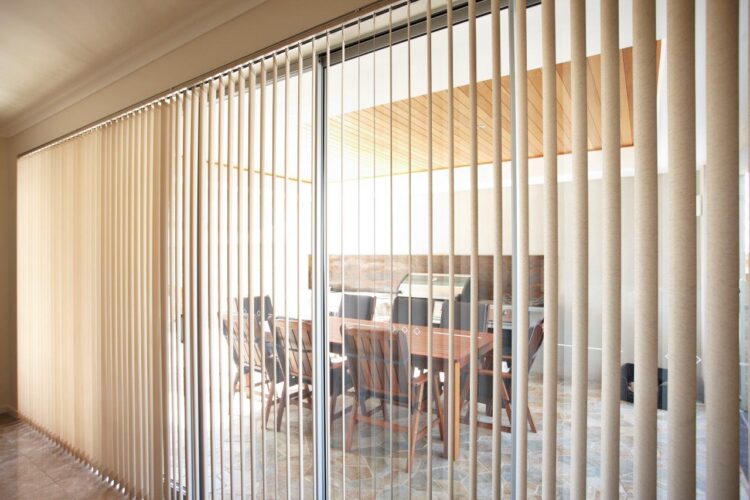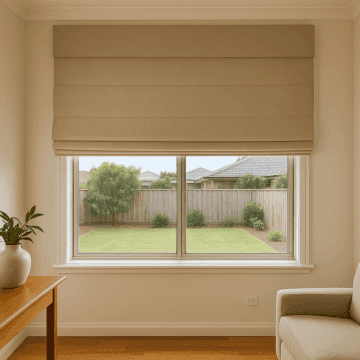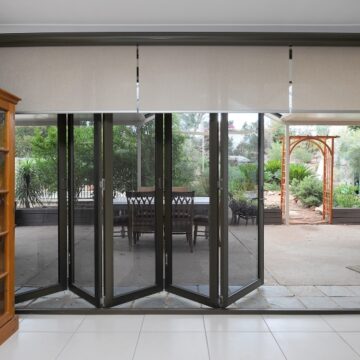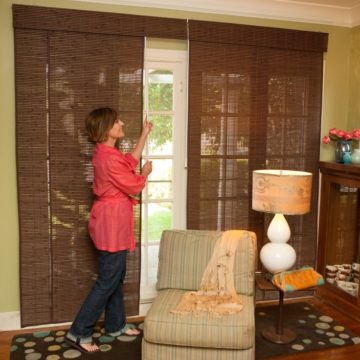That wide expanse of glass is glorious for the view, but it can make privacy, glare and summer heat a nightmare. Before you default to the first bargain pack you see at Bunnings, pause. Vertical blinds now come in nine distinct styles – from soft fabric panels to motor-ready aluminium – each with its own mix of looks, durability and price. Pick the wrong one and you could end up with slats that warp in Adelaide’s heat or fabric that soaks up every kitchen odour.
This guide sets out, side-by-side, the features, pros, cons and typical Australian costs of all nine vertical blind types homeowners and businesses can buy in 2025. You’ll see at a glance how PVC stands up to steam, where timber adds warmth, and why an S-curve profile blocks more light than a straight vane. Scan the quick tables or read the detail – by the end you’ll know exactly which option suits your window, budget and style.
1. Fabric Vertical Blinds: Soft Look on a Shoestring
If you grew up with verticals, chances are they were fabric. They remain the budget darling because woven cloth hangs like a curtain yet stacks neatly to one side – perfect for renters, first-home buyers or anyone refreshing a room on a tight spend.
Key Features & Materials
- Polyester or cotton-blend slats in 89 mm or 127 mm widths
- Light-filter, translucent or full block-out coatings
- Bottom chain links or chain-free sewn-in weights
- Operated by wand, cord and chain, or child-safe wand-only systems
Pros and Cons
Pros
- Cheapest of all vertical blind types
- Huge colour and pattern range
- Softer drape hides small track imperfections
- Easy DIY shortening and replacement slats
Cons
- Prone to staining, fading and absorbing odours
- Not recommended for bathrooms or laundries
Typical Costs in Australia
| Purchase option | Price guide |
|---|---|
| Supply-only | AU$165– $365 per m² |
| Fully installed (2.4 m sliding door) | AU$280– $560 |
Best Rooms & Styling Tips
Great in living rooms, studies and offices. Layer with sheer curtains for daytime elegance or pick a textured weave in warm neutrals to mimic linen drapes without the price tag.
2. PVC Vinyl Vertical Blinds: Moisture-Proof & Low-Maintenance
Swap soggy curtains for something that actually shrugs off steam. PVC vinyl verticals use rigid plastic vanes that won’t swell, rust or grow mould, making them one of the go-to vertical blind types for wet zones and investment properties where easy upkeep matters more than couture looks.
Key Features & Construction
- Extruded PVC slats, often textured or embossed to mimic woven cloth
- 100 % waterproof and simple wipe-clean surface
- Optional fire-retardant formulas for extra safety compliance
Advantages & Drawbacks
Pros
- Ideal for bathrooms, laundries and coastal kitchens
- Budget-friendly yet tougher than fabric
- Colours run through the material, so scratches are less visible
Cons
- Limited colour palette; whites and greys dominate
- Can warp if pressed against hot glass or metal for long periods
Ideal Applications & Design Ideas
Use matte-finish slats to soften the plastic sheen in ensuites, or pair cool white PVC with brushed-nickel tapware for a crisp, coastal vibe.
3. Aluminium Vertical Blinds: Sleek, Metallic & Durable
After an industrial edge that laughs at harsh sun? Aluminium vertical blinds deliver metal toughness in a slim, stackable form and easily outlast most other vertical blind types.
Defining Features
- Anodised or powder-coated aluminium vanes, 50–80 mm wide
- Rust-proof, UV-stable and inherently fire-resistant
- Magnetic or sewn-in bottom weights to curb clatter
- Slimline track minimises the stacked width
Pros / Cons Snapshot
Pros
- Extremely long-lasting; won’t warp, crack or fade
- Simple wipe-clean maintenance
- Metallic finish complements modern architecture
Cons
- Mid-to-high purchase price
- Limited insulation value
- May rattle if partly open in a breeze
Price Range
| Option | Typical price |
|---|---|
| Supply-only | AU$280 – $490 per m² |
| Fully installed (large window) | AU$350 – $550 |
Where They Shine & Styling Tips
Great in city lofts, offices and west-facing rooms. Go matte charcoal for a near-frameless look, or pearl white so the slats disappear into pale walls.
4. Timber Vertical Blinds: Natural Warmth With Statement Slats
Craving the richness of timber shutters but without the bulk? Vertical blinds made from real wood marry organic texture with side-draw practicality. The broad, flat slats read like floating timber panels, instantly lifting a sterile glass wall or boardroom partition.
Construction & Varieties
- Sustainably sourced basswood, cedar or poplar slats, kiln-dried for stability
- UV-seal, lacquer or oil finishes to resist fading
- 90–114 mm vane widths; choice of wand or cord tilt/stack
- Heavy-duty aluminium headrail and reinforced carriers to take the extra weight
Benefits & Limitations
Pros
- Premium, furniture-grade appearance
- Adds a hint of insulation against Adelaide’s winter chill
- Coordinates effortlessly with hardwood floors and joinery
Cons
- Heaviest of all vertical blind types; needs a robust track and secure fixing points
- Pricey and unsuited to humid rooms; moisture can cause cupping or mildew
Expected Costs
| Purchase option | Typical price |
|---|---|
| Supply-only | AU$140 – $220 per m² |
| Fully installed (2.4 m opening) | AU$350 – $500 |
Best Uses & Styling Advice
Reserve for formal dining, libraries or executive suites where the timber can shine. Stain to match skirting boards for a built-in look, or contrast pale oak slats against charcoal walls for modern Scandi flair. Keep a small tin of matching touch-up lacquer on hand to mask inevitable knocks.
5. Faux Wood Vertical Blinds: Timber Look, All-Weather Performance
Faux wood verticals bridge the gap between style and practicality. The slats copy real grain so convincingly that guests rarely spot the difference, yet they laugh off steam, sun and the odd spaghetti splash. If you like the idea of timber but your window faces the pool or a busy kitchen bench, this is the vertical blind type that keeps its good looks with almost zero fuss.
Material Specs
- Solid-core PVC or composite polymer slats embossed with real-wood texture
- 90 – 100 mm widths for a shutter-like statement
- Fully waterproof, UV-stabilised and termite-proof
Key Pros & Cons
Pros
- Cheaper than hardwood; won’t warp, crack or peel
- Wipes clean in seconds — perfect for rentals
- Manufactured in long drops, so fewer joins on tall doors
Cons
- Slight plasticky sheen if you choose high-gloss finishes
- Limited stain options compared with genuine timber
- Low-grade brands can yellow over time
Price Indicator
| Supply-only | Installed (2.4 m door) |
|---|---|
| AU$85 – $130 per m² | AU$200 – $290 |
Room Suitability & Décor Tips
Ideal for bathrooms seeking a resort vibe, coastal living areas and kid-friendly zones. Pair warm oak-look slats with rattan furniture or dot in bamboo accessories to reinforce the natural theme without risking moisture damage.
6. Sheer Vertical Blinds (Daytime Privacy)
Want to block the neighbour’s view without living in a cave? Sheer verticals use translucent fabric vanes that act like sunglasses for your windows – letting in a soft, even glow while obscuring shapes from the street. They’re a midpoint between curtains and the harder-edged vertical blind types above, giving large glass panels a lighter, floaty feel.
What Makes Them Different
- Voile, screen or linen-look polyester slats that diffuse light
- Usually 89 mm wide for a finer, curtain-style stack
- Optional dual-track system pairs sheers with separate block-out vanes
Upsides & Downsides
Pros
- Keeps rooms bright while cutting glare on TVs and laptops
- Elegant drape hides tracks and hardware
- Allows outward view during the day
Cons
- Limited privacy at night when lights are on
- Delicate weave shows dust; needs gentle vacuuming or spot cleaning
Ideal Scenarios & Styling
Perfect for north-facing living areas, sunrooms and open-plan offices. Team them with a separate block-out curtain or roller blind so you can switch from airy daylight to full darkness after sunset. Choose warm white or pale greige fabric to bounce light around and make the space feel larger.
7. Blockout Vertical Blinds: Total Light Control & Insulation
Shift-workers, home-cinema fans and nursery designers all crave one thing: darkness on demand. Block-out verticals answer with opaque fabrics that shut out glare, mute streetlights and add a welcome insulation bump.
Composition & Features
- PVC-backed or triple-weave polyester vanes stop up to 99 % of incoming light
- Optional side channels and top pelmet tighten the seal, trimming winter drafts and summer heat gain
Strengths & Weaknesses
Pros
- Delivers hotel-room black-out at the twist of a wand
- Lifts the window’s R-value, easing air-con bills
Cons
- Heavier stack; wide openings may need a centre split
- Dark colours show lint, so keep a lint roller handy
Cost Breakdown
| Supply-only | Fully installed (large window) |
|---|---|
| AU$185– $240 per m² | AU$320 – $420 |
Best Practice Installation & Decor
Choose warm neutrals to dodge the “cave” effect, mount the track 100 mm past each jamb so vanes clear the frame, and finish with a matching pelmet for cinema-grade darkness.
8. S-Curve Vertical Blinds: Enhanced Overlap For Better Block-Out
Think of S-curve verticals as the “ripple-fold curtain” of the blind world. Each vane is moulded into a gentle S shape, so when they close the edges interlock rather than merely butt together. The result is tighter light seals, prettier waves and a finish that reads more like soft drapery than office fit-out hardware.
Design Details
- PVC, fabric or aluminium slats pressed into an S profile
- Interlocking overlap minimises light gaps and boosts insulation
- Standard 89 mm width; wand or cord control
- Stacks roughly the same width as straight blinds despite extra contour
Pros, Cons & FAQs
Pros
- Improved privacy and block-out compared with flat vanes
- Stylish ripple effect hides track lines
- Better thermal performance thanks to the overlap
Cons
- 10–15 % dearer than standard profiles
- Not ideal for DIY trimming; factory cutting recommended
FAQ: Are S-shaped vertical blinds better? Yes—tests show the overlapping edges cut stray light and draughts more effectively than straight slats, making them a favourite for bedrooms and media rooms.
Pricing Guide
| Purchase type | Typical cost |
|---|---|
| Supply-only | AU$90 – $150 per m² |
| Fully installed (2.4 m patio door) | AU$230 – $340 |
Styling & Room Compatibility
Perfect for master suites, executive offices and any space chasing a luxe, wave-fold look without the bulk of full curtains. Pair them with curved sofas or round coffee tables to echo the soft silhouette.
9. Motorised Vertical Blinds: Push-Button Convenience
Tired of yanking cords on wide doors or wrestling with blinds behind furniture? Add a motor and the heaviest of vertical blind types glides aside with a tap on your phone or a quick “Hey Google, open the blinds”.
Technology & Components
- 240 V hard-wired or rechargeable lithium battery motors
- Remote, wall switch, app or full smart-home voice control
- Soft-start/stop gearboxes protect fabric edges
- Optional solar trickle charger for zero-cable refills
Advantages & Potential Drawbacks
Pros
- Effortless operation on tall or wide spans
- Cord-free design meets child-safety standards
- Sync with timers or sun sensors to slash cooling bills
Cons
- Highest upfront cost
- Needs power access; battery packs require charging every 6–12 months
- Motors have a finite 5–10 year lifespan
Cost Expectations
| Item | Price guide |
|---|---|
| Motor add-on (per blind) | AU$250 – $450 |
| Fully installed fabric vertical on 2.4 m door with motor | ≈ AU$450 – $650 |
Ideal Uses & Practical Tips
Great for elderly occupants, high clerestory windows and boardrooms where polished presentations matter. If wiring is tricky, choose batteries plus a discreet solar panel on the headrail. Always specify a manual override so you’re not left in the dark during a blackout.
Quick Wrap-Up
Every window, budget and moisture level has its match:
- Fabric – cheapest, soft drape
- PVC – waterproof, wipe-clean
- Aluminium – metallic, long-life
- Timber – premium warmth
- Faux wood – timber look, all-weather
- Sheer – daytime privacy, soft light
- Block-out – total darkness, insulation
- S-curve – tighter overlap, luxe waves
- Motorised – cordless, smart-home ready
Measure twice, compare warranties and always ask for an in-home quote so track strength, clearances and power points aren’t left to guesswork. Ready to see samples in your own space? Book a free consultation with Classic Roller Shutters Adelaide and get expert advice plus factory-direct pricing.




